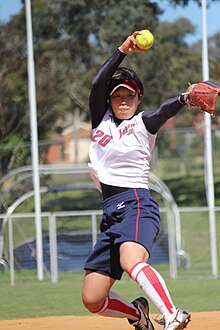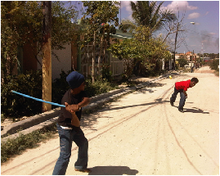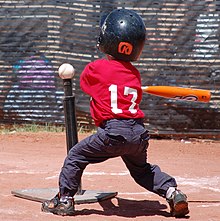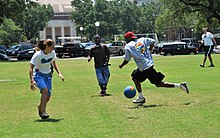
Baseball is a bat-and-ball sport that has many recreational variants (sometimes referred to as diamond sports). [1] The major sport most related to baseball is the Olympic discipline of softball, [2] with the two sports being administered internationally alongside Baseball5 (invented in 2017) [3] by the World Baseball Softball Confederation. [4]
Many variations of baseball change the game significantly. For example, many variations are played informally, with less equipment/space requirements and a softer ball, and certain variations do not feature a pitcher, and/or have the batters hit the ball using their hands or feet, [5] [6] with failure to legally hit the ball on the first opportunity resulting in an automatic out. [7] There may be a lack of baserunning, with base hits awarded according to the distance or number of bounces the batted ball takes before being fielded, and imaginary " ghost runners" advancing around the bases in lieu of actual runners. [8] [9]
There are also some bat-and-ball sports which are distinct from baseball, such as rounders, that strongly resemble it. [10]
History
Early versions of baseball had regional variations in different parts of the United States, until the modern standard became the main form of baseball after the Civil War. Some features of those early variants can still be found in modern baseball variants, such as the use of underarm pitching in softball. [11]
Baseball, as the historical national pastime of America, inspired many variants. [12] Many variations of baseball were invented in urban areas, where space was limited, and were often played with a spaldeen ball; features of the city streets, such as the manhole covers for the sewers, were often involved in regulations of the games. [13] [14] [15]
Historic variations
Massachusetts Game
The Massachusetts Game (also known as "round ball" because it was played on a circular field) was a competitor to what would eventually become the basis for modern baseball, the "New York Game". Some major differences of this game from baseball are: [16]
- The batter stood halfway between home plate and first base, with the pitcher only about half the distance from the batter as in baseball.
- There was no foul territory, so the batter could hit the ball in any direction.
- Instead of tagging runners, the fielders threw the ball at the runners in a practice that was known as "soaking" or "plugging".
- Instead of a nine-inning game, the team that scored 100 runs first won the game; this would often take a day or more to occur. [17]
Olympic sports
Softball
Softball originated as a variation of baseball, [18] and today is a very popular sport in its own right, [19] with most of the rules remaining the same as baseball. The field is significantly smaller, with the bases only 60 feet (18 m) apart, and the pitcher is required to throw the ball underarm throughout the seven regulation innings of play. [20] Softball is administered at the international level along with baseball by the World Baseball Softball Confederation, with the two sports being treated as disciplines of the same overall sport when played at the Olympics. [21] Alongside the Olympic discipline of fastpitch softball, which is the most popular variation of softball, there is also modified fastpitch softball and slow-pitch softball. [22]
Baseball5

Baseball5 (B5) is an international variation of baseball where the only equipment used is a rubber ball, and the field is a 21 m (69 ft)-square. [5] [23] Batters "self-serve" the ball, hitting it with a bare hand to start each play, with foul balls and out-of-the-park home runs not permitted. [7] [24] Each team has only five players and there are five innings in the game. [25] It is scheduled to be played at the 2026 Youth Olympic Games, and is administered by the World Baseball Softball Confederation. [26]
Informal variations

These variations of baseball generally reduce the amount of equipment and space needed to play the game, and the ball is often softer to reduce the risk of injury. [6] They may also be modified to work with fewer players; for example, some informal variations of baseball use the ghost runner rule, simulating having runners on base when a player must take their turn to bat. [8] However, the basic structure of a pitcher throwing to a batter, with the batter hitting the ball with some type of bat, is retained.
Stickball
In stickball, the bat is a broom handle, and the ball is generally a rubber ball or tennis ball. It is generally played as a street game. [27]
Vitilla
Vitilla is a variation of stickball played mostly in the Dominican Republic. Instead of a ball, a large plastic water bottle cap is thrown towards the batter, and there are only two bases to advance around before going to home plate. In addition, the strike zone is represented by a physical object behind the batter. [28]
Little League Baseball
Little League Baseball modifies some of the rules of baseball and softball to be more appropriate for children. It is played at an official level. [29]
Wiffle ball
Wiffle ball is played with a plastic bat and ball. The ball is designed to have more movement in the air, so that pitchers can more easily trick batters with different types of pitches. [30]
Corkball
Corkball does not feature baserunning: the value of a hit is measured by the distance traveled by the batted ball. The advancement of ghost runners placed on base is how runs are scored. [8]
Games with no pitcher

The following variations of baseball do not have a pitcher, meaning that the batter starts every play with possession of the ball. They may feature strikes, or the batter may automatically be out for failing to legally hit the ball into fair territory. [7]
Tee-ball
Tee-ball is a popular introductory variant of baseball for children, with the ball placed on a "batting tee" each time a batter is prepared to hit. The batter hits the ball off the tee to commence play. [31] Older players may be given the opportunity to face some pitches from their coach, making it easier for them to hit the ball while still helping them to progress toward facing an opposing pitcher. Each inning may be played until three outs, or until all players on the offensive team have had a turn to bat. [32]
Games with no bat
The following games involve the use of either the hands or the legs in order to hit the ball.
Kickball

Kickball is a popular variation of baseball, which involves batters kicking the ball with their legs. The ball is thrown underhand by the pitcher, and must roll to the batter. [33] [34]
Matball
Matball, also known as Big Base, is a variation of kickball where multiple runners can be on a base, with the bases being large mats. [35]
Variations of Baseball5
Baseball5 is a variation of baseball which does not have several elements of conventional baseball, such as pitchers and bats. [36]
Punchball
Punchball/slapball is played with the hands: batters start each play off by hitting the ball into play using their bare hands. There is no pitcher. [37]
Cuatro esquinas
Cuatro esquinas (four corners) is a Cuban street game which inspired the creation of Baseball5. [38]
Pelotica de goma
Pelotica de goma is a Venezuelan street game which has been played for over 70 years. [39]
Unorthodox variations
Box baseball
Three boxes are drawn on the ground between the "pitcher" and "batter". The pitcher has to toss the ball underhand so that it bounces in the box closest to the batter, who then has to try to hit it (with their hand) back into the box nearest to the pitcher without letting the pitcher catch the ball. The box in the middle is considered foul territory, and neither player is allowed to step into the boxes after hitting/pitching. Bases are awarded according to how many bounces the ball takes after being hit by the batter and before being caught by the pitcher, [40] with the game played to 9 innings. [41] [42] [43]
Over-the-line

Over-the-line (OTL) is a variation requiring only three players per team, and is played without gloves in some gender/age divisions. The batter stands at the point of a triangle, with his goal being to hit the ball (pitched by a teammate) over the opposing line of the triangle without the ball being caught by a defender. The fair territory is designated by two parallel lines emanating at right angles from the two corners of the triangle away from the batter. There is no baserunning, with runs scored when there are either 3+ " base hits" (uncaught fair balls) in an inning, or a " home run" (a ball landing past the furthest fielder). [44]
Stoop ball
Stoop ball is a variation where the ball is thrown by the batter at the steps of a stoop (concrete stairway) with the goal of making the rebounded ball travel away from the fielders. Bases or points are awarded based generally on the distance or number of bounces the ball takes before it is fielded. [9]
Beep baseball
Beep baseball is generally played by visually impaired or blind players, using a ball that beeps so that it can be located more easily. There are "spotters" who assist the fielders by indicating which section of the field the batted ball has been hit into. [45] The game is played to six innings.
Dartball
Dartball is played using a dartboard, with the results of each throw of the dart relating to the rules of baseball. "Batters" simulate an at-bat, with the dart's landing position on the board determining whether they get a ball or strike, and whether they ultimately reach base/advance runners already on base.
Training drills
Hotbox
Hotbox is a baseball drill or mini-game that can be played with three or more players and two to four bases. [46] In the drill, one fielder plays near each of the bases and the rest of the players are runners, who begin on any base. The fielders proceed to throw the ball to each other, playing catch. At any time, a runner may attempt to run to the next or previous base. The fielders then attempt to throw to each other and tag that runner out. If a runner is tagged out (either once or three times), he then becomes a fielder, and the fielder who tagged him out becomes a runner. Runners count how many bases they reach safely, and the player with the most bases when the group decides to quit, wins. If there are three or more bases, the runners may run in either direction.
Often, runners will get into a rundown or "hotbox," for which the drill is named; the fielders must use teamwork and skill to put the runners out. Errors often happen as well, with which the fielders must contend as the runners scramble to earn additional bases.
Fielders must take care not to hit the runners with a thrown ball. Some players may choose to devise a penalty for hitting a runner with a ball, such as a deduction in the fielder's own score. Batter's helmets are recommended. If it is too difficult for runners to advance safely, the bases can be spaced closer together to shift the balance; conversely, bases farther apart give the fielders an advantage (assuming they can throw well).Related bat-and-ball sports
Pesäpallo

Pesäpallo, also known as Finnish baseball, was invented in the 1920s, with some of it being based on baseball. [47] It has four bases placed at increasing distances between each other (such that the distance between 3rd base and home is greater than between home and 1st base.) The ball is pitched "vertically" to the batter (such that it is thrown upwards by the opposing pitcher at home base), and is hit as it lands. The game features a number of significant differences to baseball: it is not possible to hit out-of-the-park home runs, as these are considered foul balls, and batters do not have to run on fair contact, being allowed three chances to hit the ball (regardless of the result of each hit) before being forced. [48]
Rounders
Rounders involves a similar hitting of a thrown ball as baseball, with a "rounder" being scored upon rounding all four bases. There is no foul territory, so that the ball can be hit in any direction. It is popular in the United Kingdom among school children, having been played since the 1700s. [10] [49]
See also
References
- ^ "Australian baseball, softball governing bodies backing 2028, 2032 Olympic push". wbsc.org. Retrieved 2021-10-09.
- ^ "The Differences between Softball and Baseball". dummies. Retrieved 2021-09-22.
- ^ "Riccardo Fraccari: WBSC's culture of innovation brings series of firsts to 2022". www.insidethegames.biz. 2022-12-17. Retrieved 2022-12-17.
- ^ "WBSC Organisational Profile". wbsc.org. Retrieved 2021-10-11.
- ^ a b "WBSC approves esports and Baseball5 as disciplines of baseball and softball". www.insidethegames.biz. 11 December 2020. Retrieved 2021-09-06.
- ^ a b "Streetplay.com: Stickball Basics". www.streetplay.com. Retrieved 2021-09-22.
- ^ a b c Baseball5 Rulebook 2021 "In Baseball5, unlike in baseball and softball, it is the first bounce of the ball that determines whether the hit ball is fair or not: • First bounce in foul territory = batter is OUT"
- ^ a b c Brett and Kate McKay (2021-05-06). "Corkball: The Mutant Baseball Game That's a St. Louis Tradition". The Art of Manliness. Retrieved 2021-09-08.
- ^ a b "NYCdata | Uniquely NYC". www.baruch.cuny.edu. Retrieved 2021-09-21.
- ^ a b "Baseball Discovered: Rules of the Game: Rounders". Major League Baseball. Retrieved 2021-09-08.
- ^ James, Bill (2010-05-11). The New Bill James Historical Baseball Abstract. Simon and Schuster. ISBN 978-1-4391-0693-8.
- ^ Burton, Rick (2017-05-04). "Memories of and reflections on play". International Journal of Play. 6 (2): 232–234. doi: 10.1080/21594937.2017.1348330. ISSN 2159-4937.
- ^ Mills, Dorothy Seymour; Seymour, Harold (1991-05-30). Baseball: The People's Game. Oxford University Press. ISBN 978-0-19-802096-7.
- ^ Morris, Peter (2006). A Game of Inches: The Stories Behind the Innovations that Shaped Baseball : the Game on the Field. Rowman & Littlefield. ISBN 978-1-56663-677-3.
- ^ Dickson, Paul (1999). The New Dickson Baseball Dictionary: A Cyclopedic Reference to More Than 7,000 Words, Names, Phrases, and Slang Expressions that Define the Game, Its Heritage, Culture, and Variations. Houghton Mifflin Harcourt. ISBN 978-0-15-600580-7.
- ^ The Game That Got Away John Thorn https://ourgame.mlblogs.com/
- ^ Dunning, Eric; Malcolm, Dominic (2003). Sport: The development of sport. Taylor & Francis. ISBN 978-0-415-26294-1.
- ^ "softball | Definition, Rules, History, & Facts". Encyclopedia Britannica. Retrieved 2021-09-08.
- ^ "Softball's international success unites players and fans". Athletes Unlimited. 2020-07-13. Retrieved 2021-09-06.
- ^ "Are Softball Rules The Same As Baseball?". www.rookieroad.com. Retrieved 2021-09-06.
-
^ Rosenberg, Benjamin.
"Players Pay No Mind To Olympic Softball On Baseball Field". www.softballamerica.com. Retrieved 2021-09-06.
The International Olympic Committee considers baseball and softball to be a single sport
- ^ "History". www.softball.org.nz. Retrieved 2021-09-23.
- ^ Baseball5 Rulebook 2021 Pg. 3 "THE FIELD"
-
^
BaseballSA - Baseball5 Live Showcase - Round 2 | Facebook, retrieved 2021-10-11,
Timestamp is 3:20
- ^ "WBSC enters partnership with Mondo to showcase Baseball5 at Paralympics fan park". www.insidethegames.biz. 25 August 2021. Retrieved 2021-09-06.
- ^ "High five: baseball5 hits the YOG". Olympics.com. Retrieved 2021-09-08.
- ^ "Stickball | game". Encyclopedia Britannica. Retrieved 2021-09-08.
- ^ "The Clasico De Vitilla: A stickball-style tournament that just might be harder than baseball". MLB.com. 24 September 2015. Retrieved 2021-09-08.
- ^ "Little League | History & Facts | Britannica". www.britannica.com. Retrieved 2022-04-15.
- ^ "A Brief History of Wiffle Ball". www.mentalfloss.com. 2014-06-29. Retrieved 2021-09-08.
- ^ "Tee-Ball Rules Rules: How To Play Tee-Ball | Rules of Sport". www.rulesofsport.com. Retrieved 2021-09-06.
- ^ "Everything You Need To Know About Tee Ball Rules". Fatherly. 2018-05-22. Retrieved 2021-09-06.
- ^ "History Of Kickball". www.rookieroad.com. Retrieved 2021-09-06.
- ^ "Kickball". Playworks. Retrieved 2021-09-06.
- ^ Update, Physical Education (2010-07-27). "Games: Matball Variations". Retrieved 2021-09-22.
- ^ Baseball5 (B5) topendsports.com
- ^ Shapiro, Ralph (September 2012). From NYC Lower East Side To NASA Satellite Operations Manager. Xlibris Corporation. ISBN 978-1-4797-0409-5.
- ^ Proviene del cuatro esquinas, pero como tal es baseball5 (+ Video) http://www.cubadebate.cu/
- ^ Rodríguez, Luis Miguel (2019-05-21). "▷ La "pelotica de goma" dejó de ser una tradición para ser un deporte profesional #21May". El Impulso (in Spanish). Retrieved 2022-12-02.
- ^ Gould, Stephen Jay (2010-11-29). Triumph and Tragedy in Mudville: A Lifelong Passion for Baseball. W. W. Norton & Company. ISBN 978-0-393-34089-1.
- ^ Bronner, Simon J. (1977). "Concrete Folklore: Sidewalk Box Games". Western Folklore. 36 (2): 171–173. doi: 10.2307/1498972. ISSN 0043-373X.
- ^ Bronner, Simon J. (2015-03-04). Encyclopedia of American Folklife. Routledge. ISBN 978-1-317-47194-3.
- ^ Nowatzki, Edward A. (2013-03-27). I Can Hold My Own. Trafford Publishing. ISBN 978-1-4669-8145-4.
- ^ "How to Play Over-the-Line Baseball". SportsRec. Retrieved 2021-10-12.
- ^ "Beep baseball brings the competition of sports to the blind". MLB.com. 19 September 2019. Retrieved 2021-09-06.
- ^ White, Frank (2004). Good as Gold: Techniques for Fundamental Baseball. Sports Publishing LLC. p. 100. ISBN 9781582617411.
- ^ "In English". Pesäpalloliitto (in Finnish). Retrieved 2021-09-21.
- ^ Costa, Brian (2015-07-09). "What Finland Can Teach America About Baseball". Wall Street Journal. ISSN 0099-9660. Retrieved 2021-09-21.
- ^ "Rounders | English game". Encyclopedia Britannica. Retrieved 2021-09-21.
External links
- Australia Baseball5 Training Manual - features a number of training games and variations of Baseball5
- Official MLB List of Derivative Games of Baseball
This article needs additional or more specific
categories. (December 2021) |